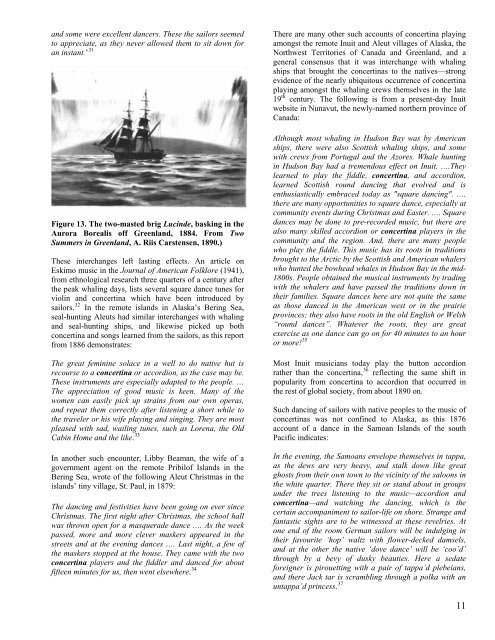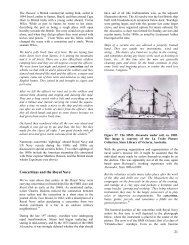The Concertina at Sea - The Anglo-German Concertina
The Concertina at Sea - The Anglo-German Concertina
The Concertina at Sea - The Anglo-German Concertina
You also want an ePaper? Increase the reach of your titles
YUMPU automatically turns print PDFs into web optimized ePapers that Google loves.
and some were excellent dancers. <strong>The</strong>se the sailors seemed<br />
to appreci<strong>at</strong>e, as they never allowed them to sit down for<br />
an instant.’ 31<br />
Figure 13. <strong>The</strong> two-masted brig Lucinde, basking in the<br />
Aurora Borealis off Greenland, 1884. From Two<br />
Summers in Greenland, A. Riis Carstensen, 1890.)<br />
<strong>The</strong>se interchanges left lasting effects. An article on<br />
Eskimo music in the Journal of American Folklore (1941),<br />
from ethnological research three quarters of a century after<br />
the peak whaling days, lists several square dance tunes for<br />
violin and concertina which have been introduced by<br />
sailors. 32 In the remote islands in Alaska’s Bering <strong>Sea</strong>,<br />
seal-hunting<br />
Aleuts had similar interchanges with whaling<br />
and seal-hunting ships, and likewise picked up both<br />
concertina and songs learned from the sailors, as this report<br />
from 1886 demonstr<strong>at</strong>es:<br />
<strong>The</strong> gre<strong>at</strong> feminine solace in a well to do n<strong>at</strong>ive hut is<br />
recourse to a concertina or accordion, as the case may be.<br />
<strong>The</strong>se instruments are especially adapted to the people. …<br />
<strong>The</strong> appreci<strong>at</strong>ion of good music is keen. Many of the<br />
women can easily pick up strains from our own operas,<br />
and repe<strong>at</strong> them correctly after listening a short while to<br />
the traveler or his wife playing and singing. <strong>The</strong>y are most<br />
pleased with sad, wailing tunes, such as Lorena, the Old<br />
Cabin Home and the like. 33<br />
In another such encounter, Libby Beaman, the wife of a<br />
government agent on the remote Pribilof Islands in the<br />
Bering <strong>Sea</strong>, wrote of the following Aleut Christmas in the<br />
islands’ tiny village, St. Paul, in 1879:<br />
<strong>The</strong> dancing and festivities have been going on ever since<br />
Christmas. <strong>The</strong> first night after Christmas, the school hall<br />
was thrown open for a masquerade dance …. As the week<br />
passed, more and more clever maskers appeared<br />
in the<br />
streets<br />
and <strong>at</strong> the evening dances …. Last night, a few of<br />
the maskers stopped <strong>at</strong> the house. <strong>The</strong>y came with the two<br />
concertina players and the fiddler and danced for about<br />
fifteen minutes for us, then went elsewhere. 34<br />
<strong>The</strong>re are many other such accounts of concertina playing<br />
amongst the remote Inuit and Aleut villages of Alaska, the<br />
Northwest Territories of Canada and Greenland, and a<br />
general consensus th<strong>at</strong> it was interchange with whaling<br />
ships th<strong>at</strong> brought the concertinas to the n<strong>at</strong>ives—strong<br />
evidence of the nearly ubiquitous occurrence of concertina<br />
playing amongst<br />
the whaling crews themselves in the l<strong>at</strong>e<br />
th<br />
19 century. <strong>The</strong> following is from a present-day Inuit<br />
website in Nunavut, the newly-named northern province of<br />
Canada:<br />
Although most whaling in Hudson Bay was by American<br />
ships, there were also Scottish whaling ships, and some<br />
with crews from Portugal and the Azores. Whale hunting<br />
in Hudson Bay had a tremendous effect on Inuit. ….<strong>The</strong>y<br />
learned to play the fiddle, concertina, and accordion,<br />
learned Scottish round dancing th<strong>at</strong> evolved and is<br />
enthusiastically embraced today as "square dancing". ….<br />
there are many opportunities to square dance, especially <strong>at</strong><br />
community events during Christmas and Easter. …. Square<br />
dances may be done to pre-recorded music, but there are<br />
also many skilled accordion or concertina players in the<br />
community and the region. And, there are many people<br />
who play the fiddle. This music has its roots in traditions<br />
brought to the Arctic by the Scottish and American whalers<br />
who hunted the bowhead whales in Hudson Bay in the mid-<br />
1800s. People obtained the musical instruments by trading<br />
with the whalers and have passed the traditions down in<br />
their families. Square dances here are not quite the same<br />
as those danced in the American west or in the prairie<br />
provinces; they<br />
also have roots in the old English or Welsh<br />
“round dances”. Wh<strong>at</strong>ever the roots, they are gre<strong>at</strong><br />
exercise as one dance can go on for 40 minutes to an hour<br />
or more! 35<br />
Most Inuit musicians today play the button accordion<br />
36<br />
r<strong>at</strong>her<br />
than the concertina, reflecting the same shift in<br />
popularity from concertina to accordion th<strong>at</strong> occurred in<br />
the rest of global society, from about 1890 on.<br />
Such dancing of sailors<br />
with n<strong>at</strong>ive peoples to the music of<br />
concertinas<br />
was not confined to Alaska, as this 1876<br />
account of a dance in the Samoan Islands of the south<br />
Pacific indic<strong>at</strong>es:<br />
f dusky beauties. Here a sed<strong>at</strong>e<br />
foreigner is pirouetting with a pair of tappa’d plebeians,<br />
and there Jack tar is scrambling through a polka with an<br />
untappa’d princess. 37<br />
In the evening, the Samoans envelope themselves in tappa,<br />
as the dews are very heavy, and stalk down like gre<strong>at</strong><br />
ghosts from their own town to the vicinity of the saloons in<br />
the white quarter. <strong>The</strong>re they sit or stand about in groups<br />
under the trees listening to the music—accordion and<br />
concertina—and w<strong>at</strong>ching the dancing, which is the<br />
certain accompaniment to sailor-life on shore. Strange and<br />
fantastic sights are to be witnessed <strong>at</strong> these revelries. At<br />
one end of the room <strong>German</strong> sailors will be indulging in<br />
their favourite ‘hop’ waltz with flower-decked damsels,<br />
and <strong>at</strong> the other the n<strong>at</strong>ive ‘dove dance’ will be ‘coo’d’<br />
through by a bevy o<br />
11




